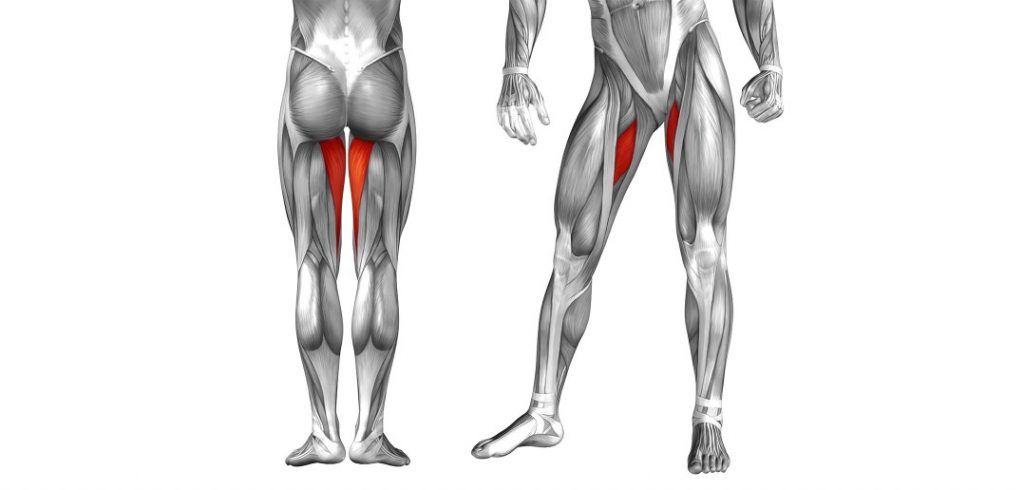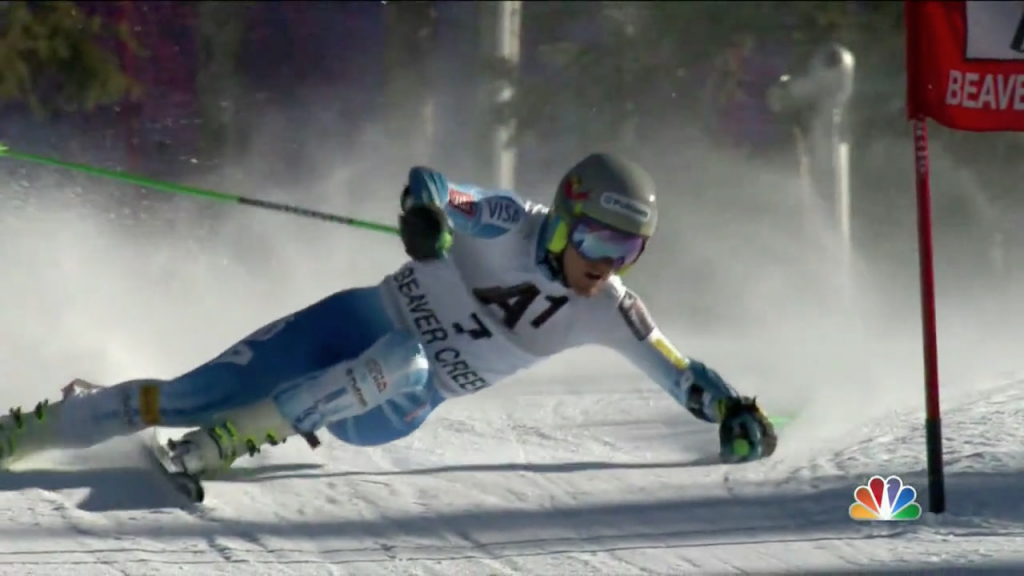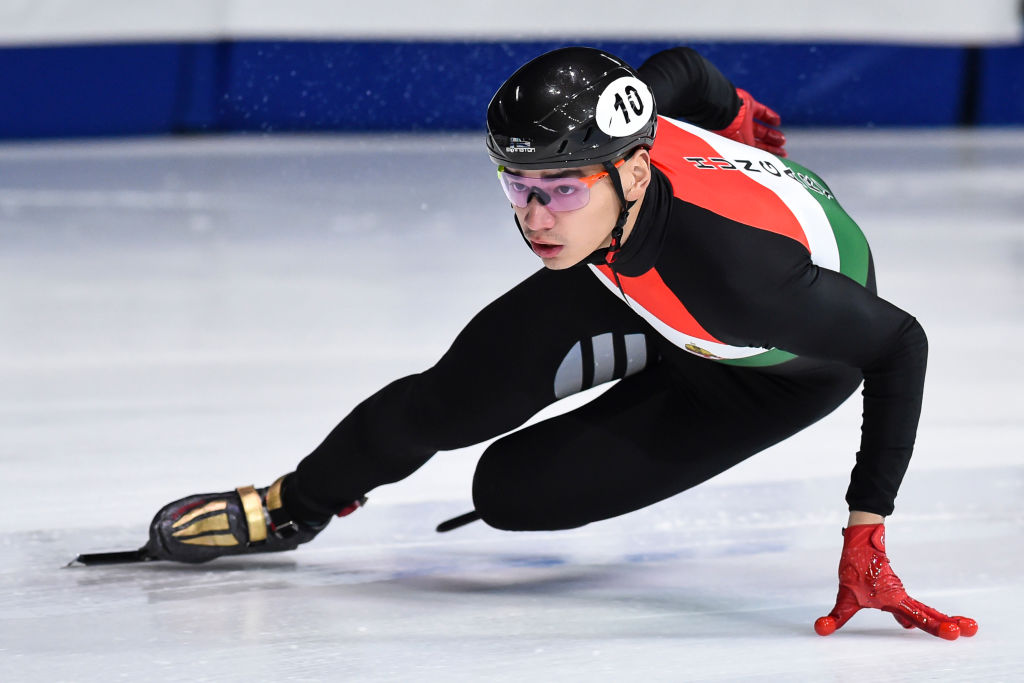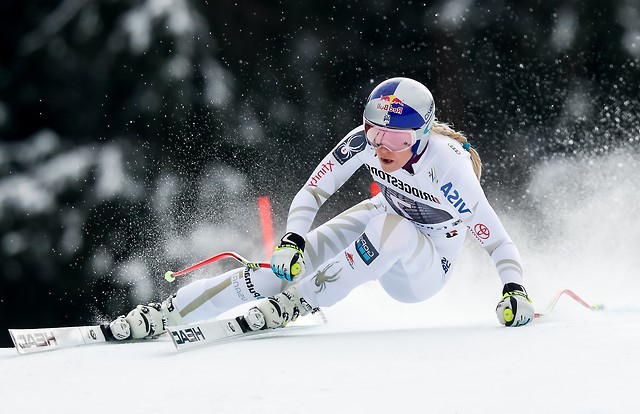- Skating
- Snowplough
- Dynamics
- Combining Dynamics with Snowplough
- Skating Step Turns
- Parallel Turns
- Foot Forward Technique
- Pivoting
- Combining Dynamics with Pivoting
Skating – Adductors
Skiing is just disguised skating. The main difference is the skis are wide and have two edges. When diverging the skis outwards at the tips into a skating stance the skis want to flatten on the snow and the stiff shaft of the ski boots will pull the knees outward. The adductor muscles need to be engaged to hold the skis on their inside edges. This is a pattern of muscle use – the adductors of both legs contracting – that should be maintained when skiing parallel.
Skis diverging yet holding the adductor muscles active on both legs.
To skate more efficiently – fall forward and let gravity generate the forward propulsion.
The key to skiing is being aware of the motion of the centre of mass due to skating and gravity.

Difference between Skating and Snowplough Braking
One difference between snowplough (converging skis) and skating (diverging skis) is that while skating requires the adductor muscles to be active a braking (stopping) snowplough requires them to be relaxed – so that a wide plough can be made from the hip joints.
Using Skating Muscle to Turn in a Plough
Integrating the skating muscle (adductor) with the plough begins with a simple act of activating the muscle on one leg only – the one you want to push you around (left leg turns you to the right). You simply get more strongly deflected due to placing one ski slightly more on edge. There is no “transfer of weight” etc. and you are not trying to apply “pressure” to a ski.
Basic Dynamics
- Skis must be travelling forward – like a bicycle
- This is mainly about using the outside leg (start of new turn) to push the centre of mass into the centre of the new turn – for the whole duration of the turn
- There is no “balance” when skiing – dynamics is the physics of disequilibrium
- You are looking for stability from organised accelerations (ski technology!)
- Notice in the photos below the outside leg is essentially straight in a skating action (flexion for absorption and other purposes is primarily at the hip joint)
- The centre of mass goes down toward the snow – and to complete the turn it comes back up – like a motorbike in a turn
- There is no “Centrifugal Force” acting on the skier – only a deflection inward away from a straight line. This deflection is used to lift the skier up at the end of the turn – which involves “finishing” the turn – I.E. turning almost back up the hill.
- Remain square to the skis (follow the skis around the turn with your body) until you are really comfortable with movement of the centre of mass and clearly aware of moving it.

Combining Dynamics with Snowplough
Dynamics is explained in terms of the mechanics of accelerations. (F=mA Newton’s 2nd Law). In skiing this means you move your centre of mass (either falling or with a push) in the direction you want to turn. You do not transfer your weight to the outside ski as is incorrectly taught in ski schools.
In the Snowplough using dynamics requires the adductors of both legs to be engaged and now the “deflection” is carried out by moving the Centre of Mass (CoM) across the skis in the direction of turning. The displacement of the CoM affects the geometry of both skis with respect to the slope (one goes flatter and the other more on edge) and that’s where the deflection comes from.
Skating Step turns
Now proper skating step turns! Incrementally moving the centre of mass inwards.
The skating step turns lead direct to parallel turns when the inside ski is simply not lifted off the snow.


Foot Forward Technique
Enabling Thibault to be safe on steeper slopes on the first morning we introduced “Foot Forward Technique”… This gives security through the start of a turn on steep terrain.
Pushing the outside (uphill initially) foot forward during the turn. The foot never gets in front of the other foot – it just tightens the turn instead.
The exercise is practised with skis off and standing in ski boots. For this static exercise we use ski pole support with the body faced downhill with the uphill foot pointing across the hill and the downhill foot pointing downhill and the heel jammed into the snow. The uphill boot is pulled over onto its inside edge and pushed forwards in a natural arc.
Here is some video of exactly the same action in ice hockey training. In skiing the overall direction of travel would be straight downhill instead of straight ahead on the flat ice.
Pivot (Skis sliding Sideways)
Pivoting is derived from the skis sliding sideways and can be developed from side slipping (It’s a braking form of turning). With a “pure pivot” as an exercise there is no forward travelling of the ski across the hill. Support for the centre of mass is now provided by support from a downhill pole plant. This is the real reason why we have ski poles! There is a full dedicated explanation of pivoting at the following link: “PIVOT“
Combining Dynamics and Pivot
- Dynamics depends on forward motion of the skis and lateral falling/pushing of the centre of mass
- Pivot depends on lateral motion of the skis – but always with the centre of mass being driven inward (toward the turn centre)
- The two can be combined – when there is both forward and lateral motion – making overall control of trajectory and speed totally under control of the skier
- In all cases there must be active adductor muscle use – and the feet must be “everted” i.e. turned outward inside the ski boots – diverging sightly (skating stance)
- The essential element to take from combining pivot and dynamics is to execute the turn transition from the uphill edge of the uphill ski – noting that the ski enters the new turn more easily than when on its inside edge and this also prevents stemming (and body rotation)

